|
Lake Bled (half day, 110 km) |
|
|
Bled is certainly one of the trademarks of Slovenia’s tourism, and it also boasts the longest tradition in the hospitality industry in our country. Its development as a resort destination was strongly marked by the Swiss physician Arnold Rikli who, in 1855, established an air, solar and thermal health spa in Bled. Nevertheless, the source of the town’s magnetic allure is still the deep blue lake with its picturesque island and breathtaking landscape, as well as the medieval castle. Perched on a high cliff, it dominates the entire surrounding countryside on one side, and the lake on the other. The castle has an interesting museum collection and a restaurant. A “must” in Bled is to take a boat ride to the island with an 18th century church. This beautiful alpine holiday resort also has thermal water and a golf course set in a stunning landscape. A host of outdoor activities are available in the area. |
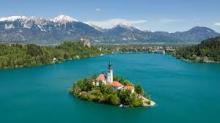 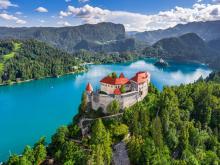 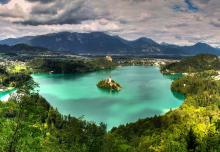 |
|
Bled - Bohinj (full day, 180 km) |
|
|
The visit to Bled in the morning is continued to the picturesque Bohinj, which is the largest natural lake in Slovenia. The surrounding mountain peaks are reflected in the lake’s limpid waters, and nature still is very much unspoiled here. At the far end of the lake, a hiking path winds its way through the forest to the 60 m high Savica waterfall. It is also possible to visit the Alpine Herdsmen’s Museum in Stara Fužina and the Oplen House beneath Studor Hill. The Alpine Herdsmen’s Museum is located in what used to be the village cheese manufactory, where all the original cheese-making equipment is preserved. In the museum, the life and work of the alpine herdsmen and cheese-makers is depicted. The Oplen House is a typical Bohinj homestead, where all the rooms still contain the original equipment and furniture, representing an interesting portrayal of the past way of life in Bohinj. Other sights worth visiting in the area are the Gothic church of St John the Baptist, as well as Mt Vogel, which is easily accessible by cable car. From the altitude of about 1,600 m, a wonderful panorama on the Julian Alps unfolds. |
 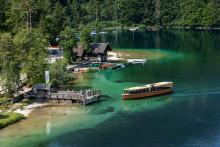 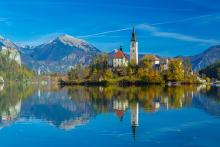 |
|
The Postojna Caves (half day, 120 km) |
|
|
The Postojna caves, listed among the largest cave systems in the world, are located only 50 km from Ljubljana. With its vast caverns and 27 kilometers of passageways and tunnels where droplets of water seeping through the ceiling have created a subterranean wonderland of limestone formations over the ages, this unique sight attracts thousands of visitors every year. The caves are easily accessible - a part of the sightseeing is by an electric train. The underground cave waters offer shelter to a unique resident - the amphibian Proteus Anguinus or “human fish”. Not far from Postojna Caves, lies the Predjama Castle - a Renaissance structure built into a cave in a vertical cliff-face, which has been converted into a museum. In a cave just behind the castle are the remains of an even older structure - the first Predjama Castle to be built on this site, which was home of the renowned robber knight, Erazem Predjamski. |
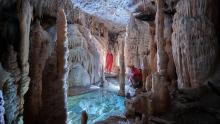 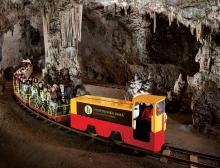 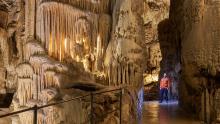 |
|
Lipica Stud Farm - The Škocjan Caves (full day, 200 km) |
|
|
In the middle of a green oasis and typical karst surroundings, interspersed with shady linden trees and oaks, lies the Lipica stud farm - the cradle of all Lipizzaner horses in the world. The Austrian Archduke Karl, son of Emperor Ferdinand, founded the stud farm in 1580. True to its 400-year tradition, the stud farm breeds full-blooded Lipizzaners for dressage, carriage rides and recreational riding. The regular program of dressage includes performances of trained Lipizzaner stallions, demonstrating traditional equestrian skills of the Spanish Riding School.Not far from Lipica lies one of the world’s most beautiful underground canyons: the Škocjan Caves.These huge caves are traversed by a torrential underground river, which makes its way through huge underground caverns in a wonderful world of limestone formations. In 1987, the Škocjan Caves were added to the UNESCO list of the world’s national and cultural heritage sites. |
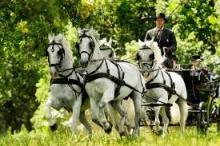 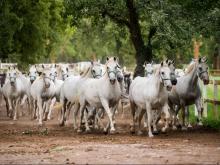 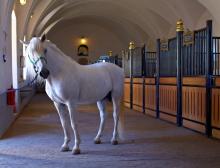 |
|
The Coastal region - Portorož and Piran (full day, 270 km) |
|
| The first section of the drive is along the motorway and, continuing later on a main road, the Karst region starts showing its features. On a clear day, a view on the Trieste bay opens while slowly descending towards the coast. Portorož, the “Port of Roses”, has been known as a health resort from as early as the mid-13th century, when the Benedictine monks from the Monastery of St Lawrence carried out preventive therapies for various diseases by means of seawater, saline solutions, algae and salt mud. Today, it prides itself with elegant hotels, restaurants, thermal spas and wellness programs, sports centers, a marina and a casino, and a lively cultural and entertainment agenda. In terms of architecture, Piran is something of a miniature extension of Venice, and is one of the three historic towns of medieval origin on the coast (besides Izola and Koper). The view from the town cathedral exhibits a wonderful harmony of slanted roofs, irregular angles, small terraces reaching out towards the daylight, mansard roofs and characteristic chimneys, as well as little shady squares and secluded gardens. Not far from the coast, the beauties of Slovenian Istria with its picturesque villages deserve attention, too. One among them is Hrastovlje, featuring the Holy Trinity church, which is decorated with narrative late Gothic frescoes including a marvelously preserved Danse Macabre. Many activities are available in the area. An idea can be to take a pleasant boat tour along the coastline, including a visit of the ancient Sečovlje saltpans, all rounded up by a good Mediterranean meal in one of the local restaurants or taverns | 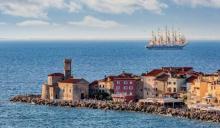 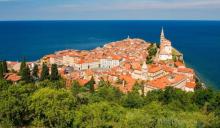 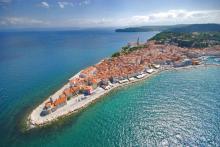 |
